
We're so RETRO it hurts the eyes
The Tandy 1000 & 1000 EX/HX PC's
Introducing the Tandy 1000
During the late 1970's and early 1980's, Tandy Corporations market-share had been over 60%. With numerous successful computer lines including the Model 1, III & 4 and the Color Computer lines, Radio Shack stores and even the contemporaious version of online stores (phone, mail and catalog services), Tandy was doing quite well. In 1983, IBM entered the home computer market with the PC/XT (Model 5150 being quite popular at the time) and things began to rapidly change. IBM with it's modular architecture, and fast growing line of productivity applications began to take over the market. These machines were compatible with the MS-DOS operarting system (and semi-clones like PC-DOS, etc...), and eventually Windows.
In an attempt to gain market share again in a highly competitive industry, Tandy decided embrace the MS-DOS environment, and introduced the Tandy 1000 PC in 1984. The 1000 (catalog number 25-1000) was not, in fact, a clone of the IBM PC, it was a clone of the much maligned PC Jr. The Jr. had some enhancements over the original PC, however it was also hobbled by incompatibilites, which were enough to eventually doom the machine. The ever watchful Tandy saw the potential in a lower cost PC for the home computer market, and the Tandy 1000 was their response. Sold thru Radio Shack stores and Tandy Computer Centers, a ready and eager network accustomed to selling computers and software was already in place. Tandy had the benefit of NOT having to design and build a marketing strategy - the company already had that in place for several years.
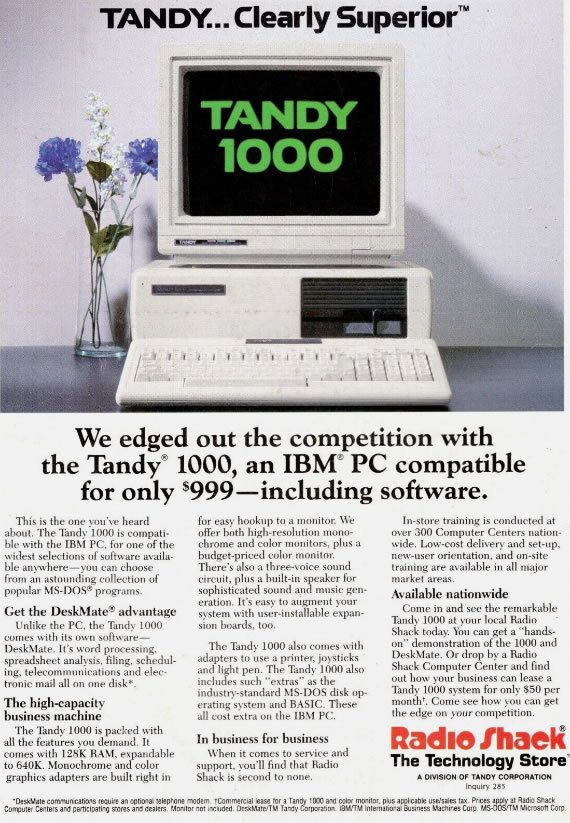
Tandy didn't just allow the 1000 to hit the ground, the machine hit the ground running! Upon release, the 1000 had the following specs:
- CPU - Intel 8088 @ 4.77MHz or 7.19MHz Turbo
- Up to two 360k 5.25" floppy drives
- 128k RAM - upgradable to 640k via ISA cards
- Enhanced CGA (similar to PC Jr) called Tandy Graphic Array providing up to 16 simultaneous colors
- 80 X 25 with 640 X200 resolution
- Texas Instrument 3 voice sound chip
- Composite video output for TV
- MS-DOS 2.1
- DeskMate GUI
- Additional 3 8-bit ISA expansion slots
For the 1000, Tandy chose to use a higly integrated approach to it's motherboard design. Whereas in the IBM PC, the video, audio, disk controller, serial port were indiviidual cards that plugged into the PC motherboard; the Tandy 1000 had all of these devices integrated saving the expansion slots for other uses. The irony of the Tandy 1000 being a PC Jr clone it that the machine provided much better compatibility to the IBM PC than IBM's own PC Jr. - and it survived on the market MUCH longer than the Jr.

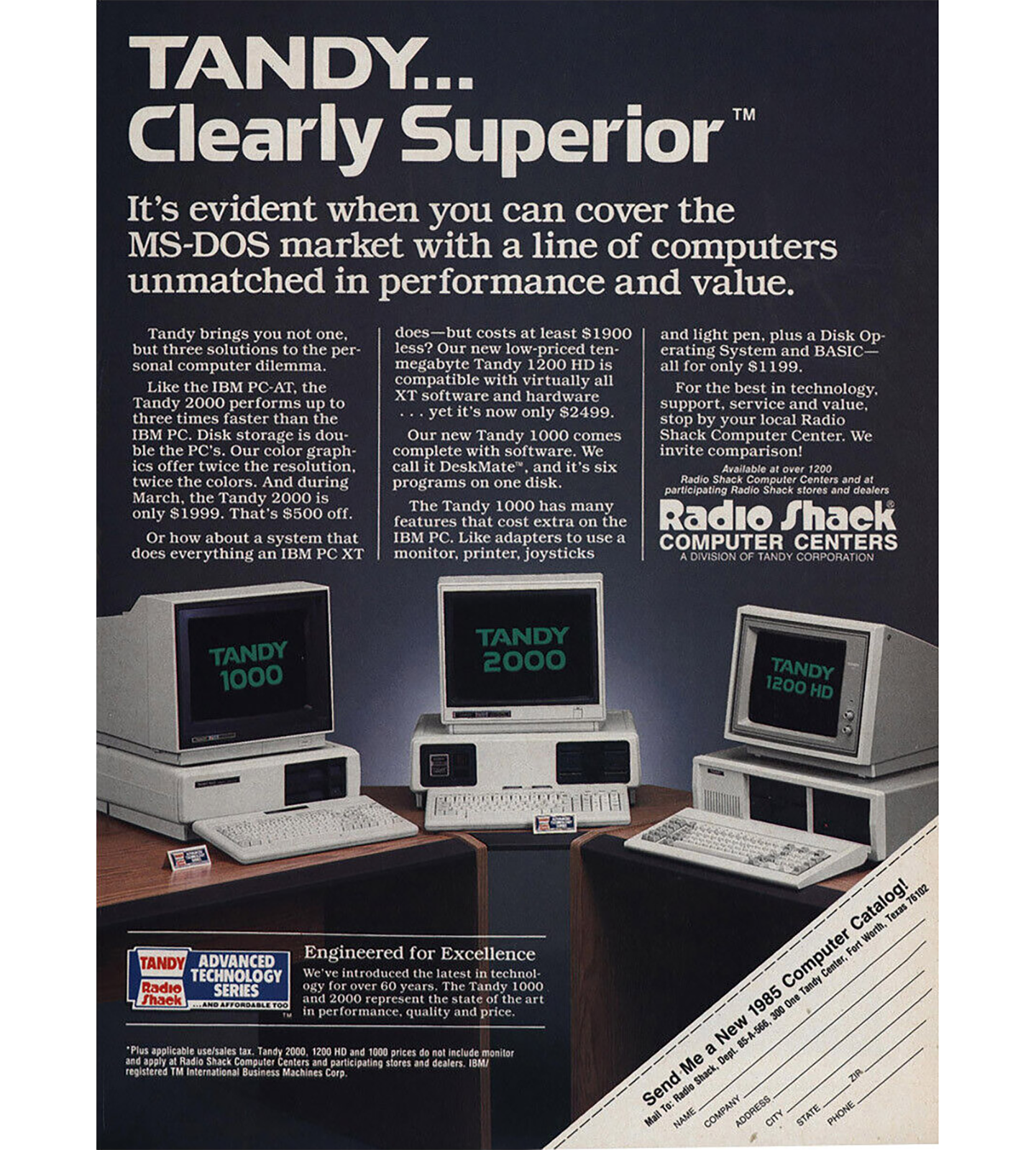
There are two more variants of the initial Tandy 1000 release worth mentioning. In 1985 Tandy release the 1000A (catalog number 25-1000A), which was a slight refresh of the 1000 with a few bug fixes a,d the inclusion of a co-processor socket for an Intel (or compatible) 8087. For most of these machines, the 1000 and 1000A models, here was a CPU upgrade available; the NEC V-20. V-20 CPUs could run at 5, 8 & 10MHz for early versions, and up to 20MHz for units made in the 1990's. Internally, the V-20 was a 16 bit processor, with an 8-bit external databus multiplexed onto the low-byte address bus lines. As stated earlier, this upgrade was possible on MOST of the Tandy 1000 & 1000A models - roughly 70%. This was an upgrade path many PC owners took advantage of, not just Tandy owners; and there were many more improvements this chip offered, and if you're interested I highly recommend looking into it, as it's beyond the intent of this article.
The final Tandy 1000 worth mentioning in conjunction with the initial release, and shown blatantly on it's case badge, is the Tandy 1000HD. As you may have already guessed, the HD stands for hard drive. With a catalog number of 25-1001, this was a Tandy 1000 with a controller and hard disk slapped into it at the factory.
In early 1985, Tandy released the Randy 1200HD, catalog number 25-3000. While not a large departure from the architecture that made the 1000 a success - the specs were identical. What was diferent aout the 1200HD from the 1000 or the 1000HD? The Tandy 1200HD came with one 360k floppy drive, and a Winchester 10MB hard drive.


Introducing the Tandy 1000 EX & HX
Small footprint, PC campatibility
Designed as an entry level PC compatible computer, the Tandy 1000EX was released in 1987, and primarily marketed against the IBM PCjr. The 1000EX was a compact computer with an integrated keyboard, and a 5.25" 360k floppy drive integrated into the right side of the case. The computer came with 256kB of RAM, MS-DOS/GW-Basic 2.11, and DeskMate. DeskMate was unique for the time, having previously been released for the CoCo under OS-9, and contained useful apps like a text editor, spreadsheet, calculator, notepad, calendar, phone directory and a paint style application. Many of the same apps integrated into modern computers. This system initially sold for $799, and an upgrade to MS-DOS was available for $29.99.
The CPU in the 1000EX was the Intel 8088, with software selectable speeds of 7.16/4.77MHz the PC did boot at 7.16MHz by default. While the computer shipped with 256k of RAM, it was upgradable to 640k via add-on cards. Internally, there was one expansion slot that, when used with the RAM expansion card, would give you two additional expansion slots. Display resolution was switchable between 80 or 40 characters by 25 lines. Green or CGA
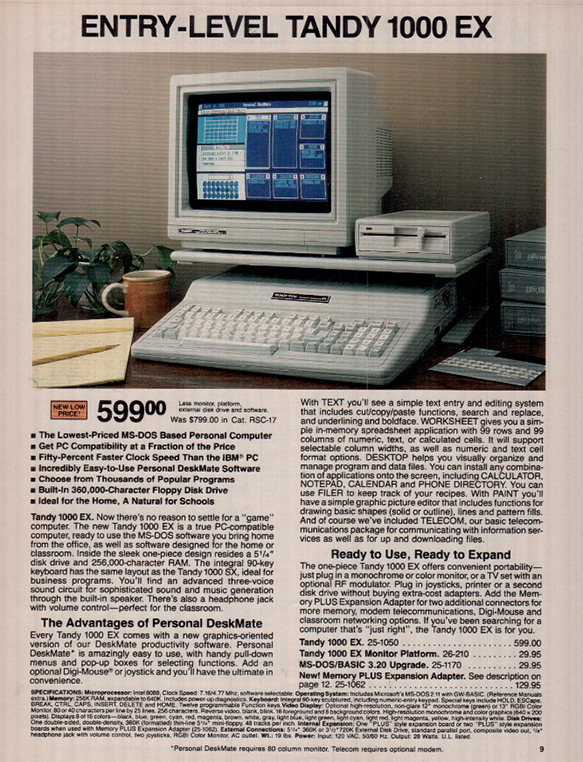
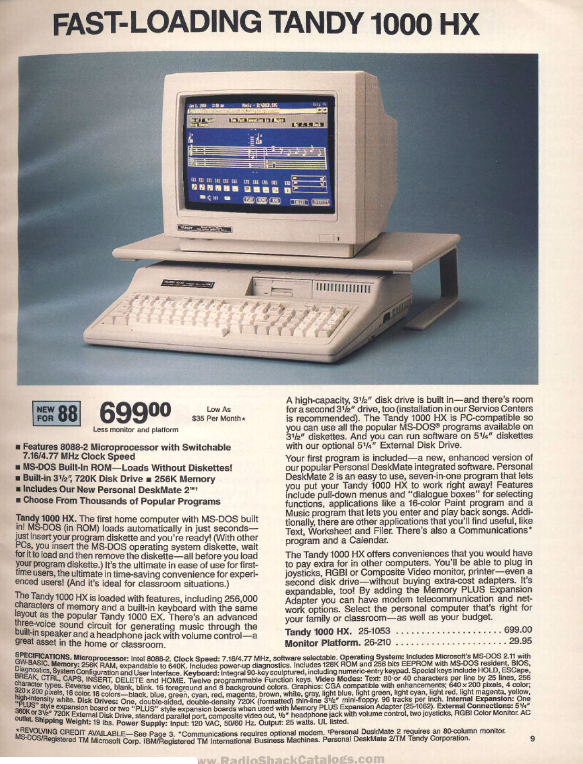
Released in 1988 and appearing Tandy computer catalogs in 1988, the Tandy 1000HX was considered the 'bigger brother' of the 1000EX. It was still considered an entry level PC. Much of the internals were the same as the orginal EX, but there were a few differences. For example, MS-DOS 2.11 was contained in ROM (read only memory), which lead to faster boot times. To access the ROM based DOS, one only needed to power up the PC without a bootable disk in the now 3.5" floppy drive, located in the front of the case, instead of the right side. Like the 1000 EX, The 1000HX defaulted to the 7.16MHz in it's identical Intel 8088 CPU, with 4.77MHz being available, selecable by software requirements.
Both the 1000 EX and HX would take the same 640kb Plus card memory upgrade, which also allowed for DMA access. The Plus card was electrically identical to the well established ISA slot standard, but used a Berg style 62 pin connector instead of the ISA style connector. Other PLUS cards could be installed to add serial ports, a 1200 baud modem, a clock/calendar and bus mouse board and a proprietary Tandy network interface.
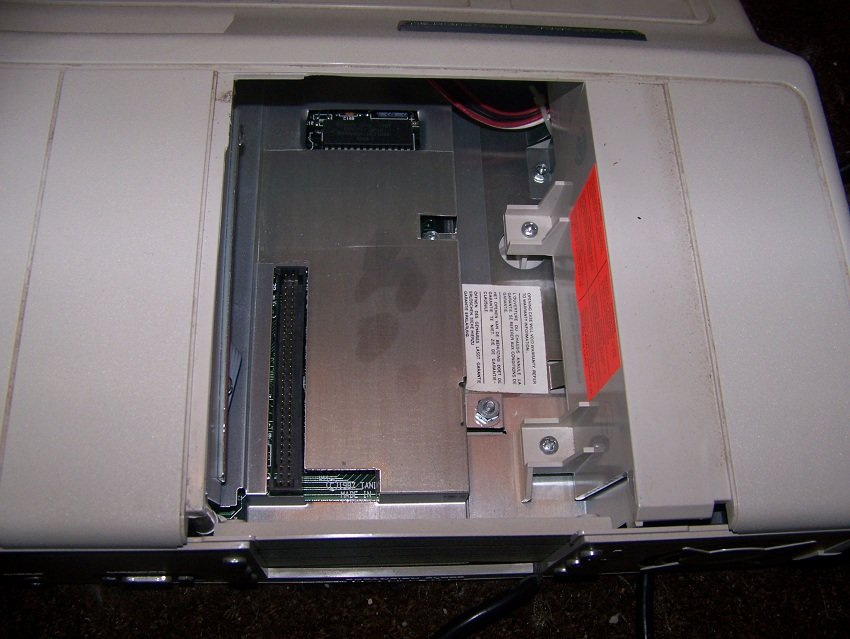
The Tandy 1000EX and 1000HX are similar to the earlier 1000s except now they are using the NCR8496 chip for audio, which are essientially clones of the TI SN76496, as well as the real TI SN76496s. The TI SN76489 audio chip was used in many different computers and video game consoles of the day, including the Sega Master System and Genesis. While the two chips (NCR & TI) work almost identically, there are differences, mostly requiring slightly different electrical components on the motherboard, and it's really a coin-flip as to which chip you would get when buying one of these machines. If you want a more technical description of the differences, this link to Nerdly Pleasures has a far more indepth analysis than I'm willing to go into.
For video, both models had the same options. There was an RGBI interface for using the standard Tandy CGA graphics with a 9 pin Tandy monitor. Additionally, both the 1000EX and HX came with composite video output, in order to use the PC with a television set. The 1000 HX was the last Tandy computer to be so equiped, ending a feature that started with the first TRS-80 Color Computer.

